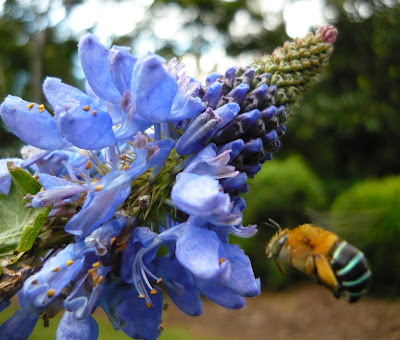A frequent visitor to our gardens are the native 'blue banded' bees. They are slightly bigger and fatter than a honeybee. These bees are attracted to blue flowers. The flower featured here is a hedgehog sage.
This one (above) is sipping nectar from a mauve plectranthus flower.
Blue banded bees are capable of buzz-pollination, which is a method they use to vibrate the pollen from flowers. Industry is trialling them as pollinators for tomatoes in greenhouses.
It's nice to see these bees bumbling about in the garden.
Sandi x




6 comments:
Hi Sandi, you have single-handedly solved a mystery that has been bugging me for a fortnight.
I was visiting my parents recently and saw this bee whilst picking flowers with my niece.
It was dazzling in its golden glory although I must admit I didn't notice the blue bands at the time.
The puzzlement lay in what type of bee it was as I thought perhaps it was the dreaded European version.
Thank you for clearing that up, next time I look more closely for the blue bands.
xx Felicity
We dont get bees like that here - I can see many different features.
Hello from Toronto, Ontario, Canada. One of your other 'followers' Felicity suggested your blog to me, and I am glad she did.
You have a wonderful collection of photographs and subjects. I look forward to seeing more.
Daniel
Explore. Dream. Discover.
http://daniels-view.blogspot.com/
--
how cool! love how the bees are blue, really striking looking. people find it odd when I try to save a bee from the house and set it free, but its still alive so it deserves to live :)
Sandrine said we should visit your site so here I am and I love it already, going to look around for a while longer , I have my garden called Tinksmeadow no matter where I move , my garden moves with me. I am looking forward to seeing everything here
I just popped over after noticing we spell Sandi the same way. Funny what brings one to a blog;-) I too am a poker! Love your pictures.
Post a Comment